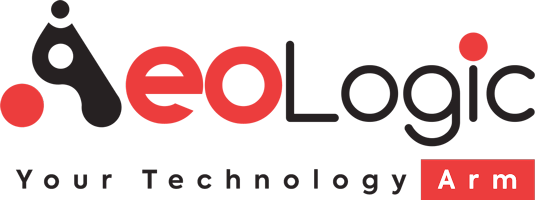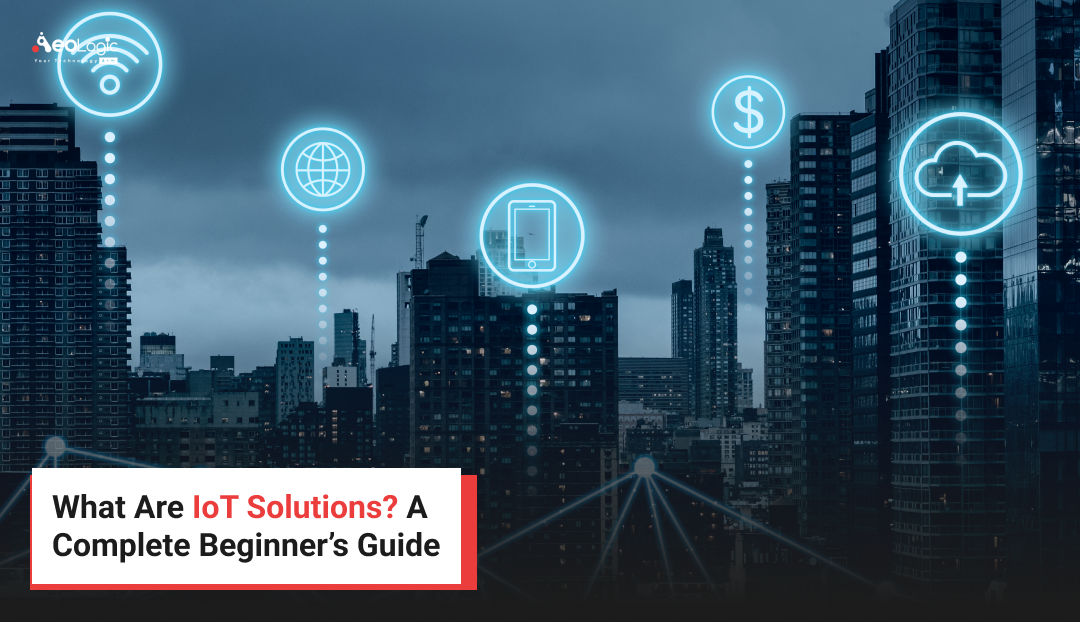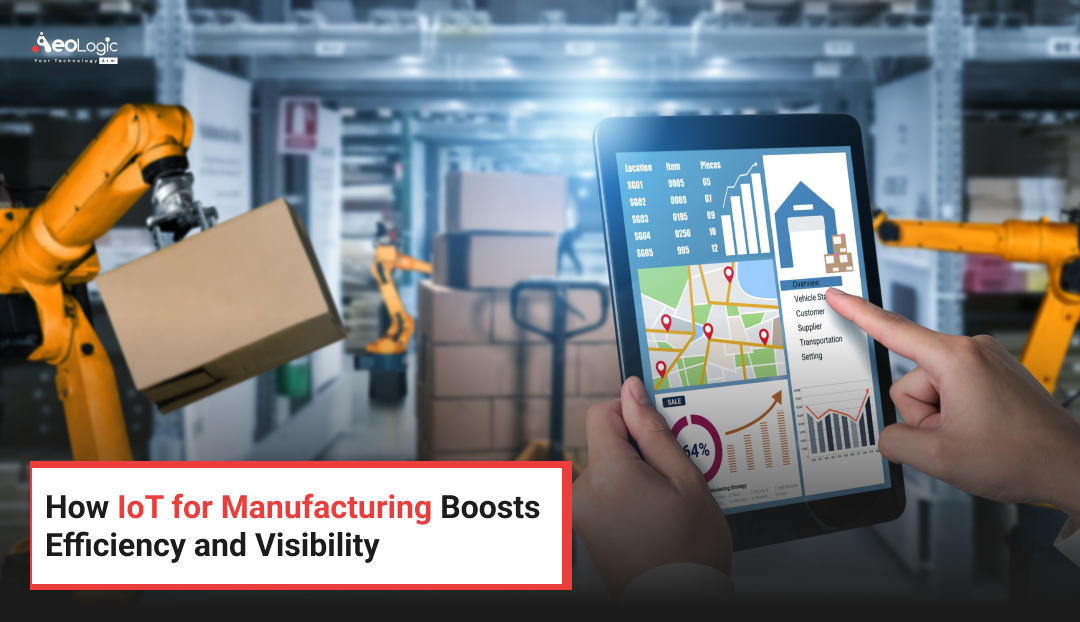PToday, technology is changing everything around us. We are surrounded by smart devices — from phones to watches, TVs to cars. These devices talk to each other and share data automatically. This is possible because of something called IoT. But what are IoT solutions actually? How do they work? Why are companies investing so much in them? In simple words, IoT stands for Internet of Things. It means connecting everyday physical devices like machines, lights, sensors, and appliances to the internet so they can collect and share information. IoT solutions are systems that help use this data in a smart way — to monitor, control, and automate different tasks. They make work easier, faster, and more efficient. In this blog, we will discuss in simple terms what are IoT solutions, how they work, their benefits, challenges, examples, and what the future of IoT looks like.
What Are IoT Solutions?
IoT solutions are basically a mix of devices, software, and networks that connect physical objects to the internet. These objects can be anything — a machine in a factory, a temperature sensor in a farm, or even a smart bulb in your home.
These devices collect data through sensors and send it to a system or platform through the internet. The data is then analyzed to make smart decisions — like turning off lights automatically, predicting when a machine will break down, or sending alerts when temperature gets too high.
So when we say IoT solution, it means a complete system that includes:
-
Smart devices or sensors
-
Connectivity (Wi-Fi, Bluetooth, or cellular)
-
Cloud software or data platform
-
A user interface or dashboard
All these together make it possible to track and control things remotely.
Why IoT Solutions Are Important
IoT solutions are important because they make things smart. In the old days, machines or tools worked alone. But now, everything can be connected and controlled through the internet.
Here are some simple reasons why IoT is important:
-
Automation – IoT helps in doing tasks automatically without human work. For example, lights that turn on when someone enters a room.
-
Better Efficiency – Machines can work smarter and faster with less waste.
-
Remote Control – You can control devices from anywhere using your phone or computer.
-
Real-Time Monitoring – You get live data about what’s happening. For example, checking temperature, location, or performance anytime.
-
Cost Saving – IoT helps reduce energy waste, downtime, and human error.
-
Safety and Security – IoT can send alerts when something goes wrong, like fire detection or machine failure.
Because of these benefits, IoT is now used everywhere — from homes to industries, hospitals, schools, and even cities.
How IoT Works – Step by Step
Let’s understand how IoT solutions actually work in simple steps:
-
Sensors Collect Data
Every IoT device has sensors. They collect information like temperature, motion, humidity, location, or speed. -
Data is Sent to Cloud
The data from sensors is sent through the internet (Wi-Fi, Bluetooth, or 4G/5G) to a cloud server. -
Data is Processed
The software analyzes the data to find patterns or problems. -
Action is Taken
Based on the analysis, the system takes action — like turning on AC, sending alerts, or updating dashboards. -
User Interaction
The user can see results or control things through an app or dashboard.
So IoT basically connects the physical world to the digital world.
Main Components of IoT Solutions
To understand IoT properly, it helps to know its main parts. Every IoT solution is made up of a few simple components that work together.
Sensors and Devices
These are the things that collect data. Sensors can measure temperature, light, sound, movement, humidity, and many other things. For example, a smartwatch has sensors that track heart rate and steps.
Connectivity
After collecting data, the device needs to send it somewhere. This is done through internet connections like Wi-Fi, Bluetooth, 4G/5G, or satellite. Without connectivity, IoT will not work because data cannot travel.
Cloud or Data Platform
All data from devices goes to a cloud or a central system. This is where the information is stored and processed. Cloud helps to handle large amounts of data safely.
Software or Application
Software is what helps users understand the data. It could be a mobile app or a dashboard that shows reports, alerts, and graphs.
User Interface
This is where humans interact with the IoT system. It can be as simple as a phone app or a big computer screen in a factory showing machine status.
All these parts work together — sensors collect data, connectivity sends it, cloud stores it, and software shows results.
Types of IoT Solutions
There are different types of IoT systems depending on where and how they are used. Here are some of the most common ones.
Consumer IoT
This is what most people use at home. Examples include smart bulbs, voice assistants like Alexa, smart TVs, and fitness watches. These devices make life easy and fun.
Industrial IoT (IIoT)
Factories and manufacturing plants use this type of IoT to monitor machines and production. It helps prevent machine breakdowns and improve performance.
Commercial IoT
Used in offices, shopping malls, hospitals, and hotels for energy management, security, and tracking. For example, smart lighting systems or visitor tracking.
Agricultural IoT
Farmers use IoT devices to monitor soil moisture, weather, and crop health. It helps them grow more food with less effort.
Smart City IoT
In cities, IoT is used for traffic lights, waste management, parking systems, and public safety. It helps city governments manage things better.
Healthcare IoT
Hospitals and doctors use IoT to track patients’ health remotely. Devices like smart monitors and connected wristbands help in saving lives.
Real-Life Examples of IoT Solutions
IoT is all around us even if we don’t notice it. Here are some examples to make it clear.
Smart Home Systems
Smart thermostats like Nest learn your habits and adjust room temperature automatically. Plugs and bulbs can be controlled using your phone.
Fitness Trackers
Watches like Fitbit or smart bands track your steps, sleep, and heartbeat using IoT sensors.
Connected Cars
Modern cars have IoT systems that alert drivers about maintenance, track location, and even call for help in emergencies.
Agriculture Sensors
Farms use IoT sensors to measure soil quality, water level, and crop growth to make farming more efficient.
Industrial Machines
Factories use IoT to check if machines are working properly. If something is wrong, the system sends alerts before failure happens.
Healthcare Devices
Hospitals use IoT-based devices to monitor patients’ heart rate, oxygen levels, and movement in real time.
These examples show that IoT is not just for tech companies — it’s everywhere around us.
Benefits of IoT Solutions
IoT is growing fast because it makes life and work easier. It connects things that were never connected before. Here are some simple and clear benefits that show why IoT solutions are so useful today.
Better Efficiency
IoT helps automate many daily tasks. For example, in factories machines can turn on and off automatically when needed. It saves time and reduces mistakes.
Cost Saving
When devices are smart, they use energy properly. Like smart lights that turn off when no one is in the room. This saves electricity and money.
Real-Time Monitoring
IoT gives live updates. If a machine stops or something breaks, you know it instantly. This helps companies react quickly.
Better Decision Making
The data collected by IoT helps businesses understand patterns. For example, shops can know which products sell more and restock on time.
Safety and Security
IoT can track vehicles, monitor health, or alert about danger. For example, sensors can warn about gas leaks or fire early.
Convenience
Smart home devices make daily life simple. You can turn on AC, lights, or even coffee machine using your phone.
Growth Opportunities
IoT opens new ways for companies to grow by using technology. Many businesses are using IoT to improve their products and services.
Challenges of IoT Solutions
Even though IoT gives many benefits, it also has some challenges. Companies must handle these carefully to get good results.
Security Problems
Since IoT connects to the internet, hackers can try to steal data. Companies need to use strong security systems.
Privacy Concerns
IoT devices collect a lot of personal data. If it is not protected, it can be misused.
High Cost in Beginning
Setting up IoT devices, software, and networks needs investment. It may be expensive at the start.
Internet Dependence
If the internet connection fails, IoT systems can stop working. This is a big problem in areas with poor connectivity.
Compatibility Issues
Different IoT devices come from different companies. Sometimes they don’t work well together.
Data Overload
IoT creates a huge amount of data. Managing and analyzing all of it is difficult for small businesses.
Common Use Cases of IoT Solutions
IoT is used in almost every field now. Here are some simple examples that show how different industries use it.
Smart Homes
Smart home systems connect lights, TVs, fridges, and doors. You can control them through your phone or voice commands.
Healthcare
Hospitals use IoT for patient monitoring. Devices track heartbeat, temperature, and other vitals, sending reports directly to doctors.
Transportation
IoT helps in tracking vehicles and traffic. GPS systems and smart sensors make delivery and travel easier.
Agriculture
Farmers use IoT to check soil moisture, temperature, and rainfall. It helps them grow crops better and save water.
Retail
Shops use IoT to track inventory and improve customer experience. Smart shelves show what items are low in stock.
Manufacturing
Factories use IoT to check machine performance and avoid breakdowns. This improves productivity.
Smart Cities
Governments use IoT to manage streetlights, parking, and garbage collection. It helps in making cities cleaner and more organized.
The Future of IoT Solutions
IoT is still growing. In the coming years, it will become even more powerful and common. Here are some things we can expect in the future.
More Connected Devices
Soon, almost everything we use will be connected — not just phones and TVs, but also furniture, clothes, and even roads.
Smarter Homes and Cities
Homes will learn from our habits. Cities will use IoT for traffic, streetlights, and pollution control. Everything will work automatically to make life easier.
Better Data Security
As more devices connect, data safety will become very important. Companies will build stronger systems to protect personal information.
Faster Networks (5G and Beyond)
5G internet will make IoT faster and more stable. Devices will share data in real time without delay.
AI and IoT Together
AI and IoT will combine to make devices think smarter. For example, machines that can learn when to repair themselves.
So, the future of IoT looks very bright. It will keep changing how we live and work every day.
Frequently Asked Questions (FAQs)
1. What does IoT stand for?
IoT means Internet of Things. It connects physical objects to the internet so they can send and receive data.
2. What are IoT solutions used for?
They are used for automation, tracking, monitoring, and control in homes, offices, factories, farms, and cities.
3. Is IoT hard to understand?
Not really. It sounds complex, but it’s just devices talking to each other through the internet.
4. Can IoT work without internet?
No. IoT needs an internet connection to send and receive data.
5. Is IoT safe?
It can be safe if companies use strong passwords, firewalls, and encryption. Without security, it can be risky.
6. How expensive is IoT?
The cost depends on the project. Smart home devices are cheap, but industrial IoT systems can cost more at the start.
7. Who uses IoT the most?
IoT is used by people and companies everywhere — in manufacturing, healthcare, agriculture, retail, transport, and homes.
Conclusion
Now you know clearly what are IoT solutions and why they matter so much today. In simple words, IoT connects devices to the internet so they can work together smartly. It helps in automation, saves time, and makes life comfortable.
From smart lights in homes to huge machines in factories, IoT is changing everything. It reduces manual work, gives real-time data, and helps people make better decisions.
Yes, there are challenges like security, privacy, and cost, but as technology improves, these problems are slowly getting solved. The future will see IoT everywhere — in our homes, offices, schools, farms, and even cars.
IoT is not just a buzzword; it is a real solution for a smarter world. It connects people and machines to make everything work better and faster. If you want to start learning about technology, understanding IoT is the best first step.

Passionate about breaking down complex tech into simple ideas. Covers everything from AI and software development to gadgets and emerging tech trends.






